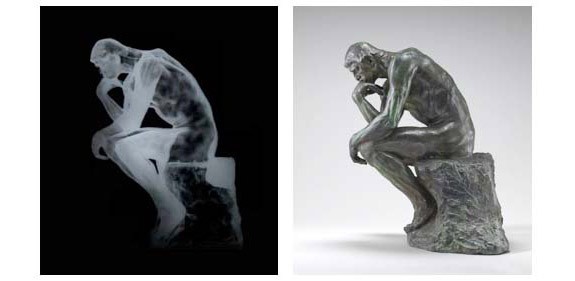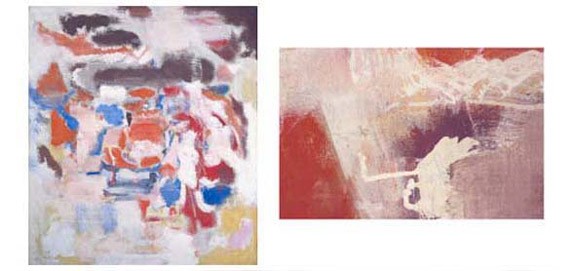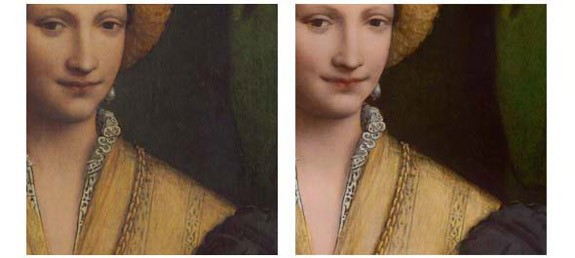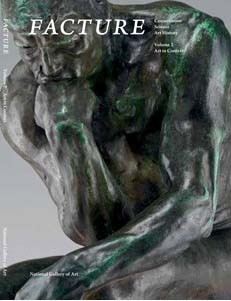Technical study of Giotto’s Madonna and Child in the collection of the National Gallery of Art situates this work in the context of the artist’s surviving oeuvre. The painting shares intriguing technical similarities with three other panels by Giotto—new evidence that these works originally formed parts of a much larger altarpiece. Giotto’s use of previously unrecognized art materials may offer further evidence linking the paintings.
Facture Volume 2: Art in Context
Edited by Daphne Barbour and Suzanne Quillen Lomax
Volume 2 of the Gallery's biennial journal Facture, presents great works of art in new contexts. Examining the art of two very different eras—the Italian Renaissance and the 20th century—the essays in this volume share a common approach. Essays start with meticulous material and analytical study of works of art, then place the findings in a broader historic context, providing new perspectives on well-known works.
Giotto

Giotto, Madonna and Child, c. 1310/1315, tempera on poplar panel, Samuel H. Kress Collection, 1939.1.256

Giotto’s revisions are shown in details of the rose in visible light (left) and false-color infrared reflectography (right) (RGB channels assigned to three wavelength bands: value centered at 1000 nm, green at 1200 nm, red at 1600 nm).
Andrea Briosco, called Riccio
Another essay considers an autograph bronze relief by Riccio, The Entombment. In this first technical overview of Riccio’s reliefs, the author considers the National Gallery relief in the context of 32 documented and three undocumented reliefs by the artist. The conclusions, which challenge previous theories on the origins of The Entombment, revise understanding of its place of in Riccio’s oeuvre.
Auguste Rodin

X-radiograph of Auguste Rodin, The Thinker (Le Penseur), model 1880, cast 1901, bronze, National Gallery of Art, Gift of Mrs. John W. Simpson, 1942.5.12. The x-radiograph reveals the sculpture was cast in one piece. A lead counterweight is also evident under the figure.
Essays on works from the 20th century include a study of Auguste Rodin’s bronze sculptures that, by focusing on works from the National Gallery’s Simpson Collection, examines works cast during the artist’s lifetime, under his supervision. Combining archival research and technical analysis of seven bronzes, this article explores Rodin’s close creative exchange with his primary bronze founder and patinator, illuminating his personal aesthetic. Another essay presents John Marin’s choice of watercolor pigments in the context of contemporary color theory. As the authors draw on a wealth of contemporary documentation and extensive technical study they demonstrate that in his early career Marin employed a severely restricted palette of just three primary colors, recommended by writers influenced by already old-fashioned color theory. They show that later, Marin’s exposure to new ideas in Paris and in the New York circle of Alfred Steiglitz encouraged a dramatic expansion of his range of pigments.
Mark Rothko

[Left] Mark Rothko, Untitled, 1948, oil on canvas, National Gallery of Art, Gift of The Mark Rothko Foundation, Inc., 1986.43.4. Copyright © 1998 Kate Rothko Prizel and Christopher Rothko. [Right] A detail shows a bent paint drip, suggesting that Rothko turned the canvas during painting.
Mark Rothko’s pivotal early works known as multiforms are the subject of another essay. Detailed analysis of the multiforms in comparison with Rothko’s later works reveals not only the birth of Rothko’s abstraction but also creative experimentation with the paint medium that presages the enigmatic paint surfaces of his mature work.
Bernardino Luini

Bernardino Luini, Portrait of a Lady (detail), 1520/1525, oil on panel, National Gallery of Art, Washington, Andrew W. Mellon collection, 1937.1.37. The detail on the left shows the painting before conservation treatment. After treatment (right) removal of discolored varnish and repaint revealed Luini’s delicate sfumato in the face and the skillful painting of the opulent costume.
An In Focus essay stemmed from research carried out in conjunction with a major conservation treatment of Bernardino Luini’s Portrait of a Lady. Costume history revealed the restrained opulence of the lady’s garments, technical analysis illuminated the painter’s refined technique as he made delicate variations of tones of black, and conservation treatment uncovered Luini’s subtle modulations of black on black.
Another In Focus contribution arose from a unique opportunity for technical study. The exhibition, Warhol: Headlines, organized by the National Gallery of Art, brought together four pivotal paintings, including the Gallery’s own A Boy for Meg, 1962. Despite their significance, these paintings had not been analyzed from a materials’ standpoint. The authors evaluate Warhol’s early choices of paint medium, revealing previously unrecognized experimentation at the moment of his transition between two artistic contexts: his early work as a commercial artist and the pop art for which he is best known.
Contents
The Creation of Giotto’s Madonna and Child: New Insights
Joanna R. Dunn, Barbara H. Berrie, John K. Delaney, Lisha Deming Glinsman
Riccio in Relief: Documented Sculpture as a Technical Context for The Entombment
Dylan Smith
Auguste Rodin’s Lifetime Bronze Sculptures in the Simpson Collection
Daphne Barbour, Lisha Deming Glinsman
Movements in Paint: The Development of John Marin’s Watercolor Palette, 1892–1927
Cyntia Karnes, Lisha Deming Glinsman, John K. Delaney
Mark Rothko’s Multiforms, 1946–1950: Transforming the Painted Surface
Allison Langley, Suzanne Quillen Lomax
In Focus
Sfumato and Sheen: Bernardino Luini’s Lady in Black
Michael Swicklik, Barbara H. Berrie, Gretchen Hirschauer
Andy Warhol’s Early Paint Mediums
Molly Donovan, Jay Krueger, Suzanne Quillen Lomax, Christopher Maines
You May Also Like
Contact us at [email protected] or Conservation Division, National Gallery of Art, 2000B South Club Drive, Landover, MD 20785
